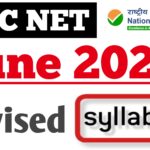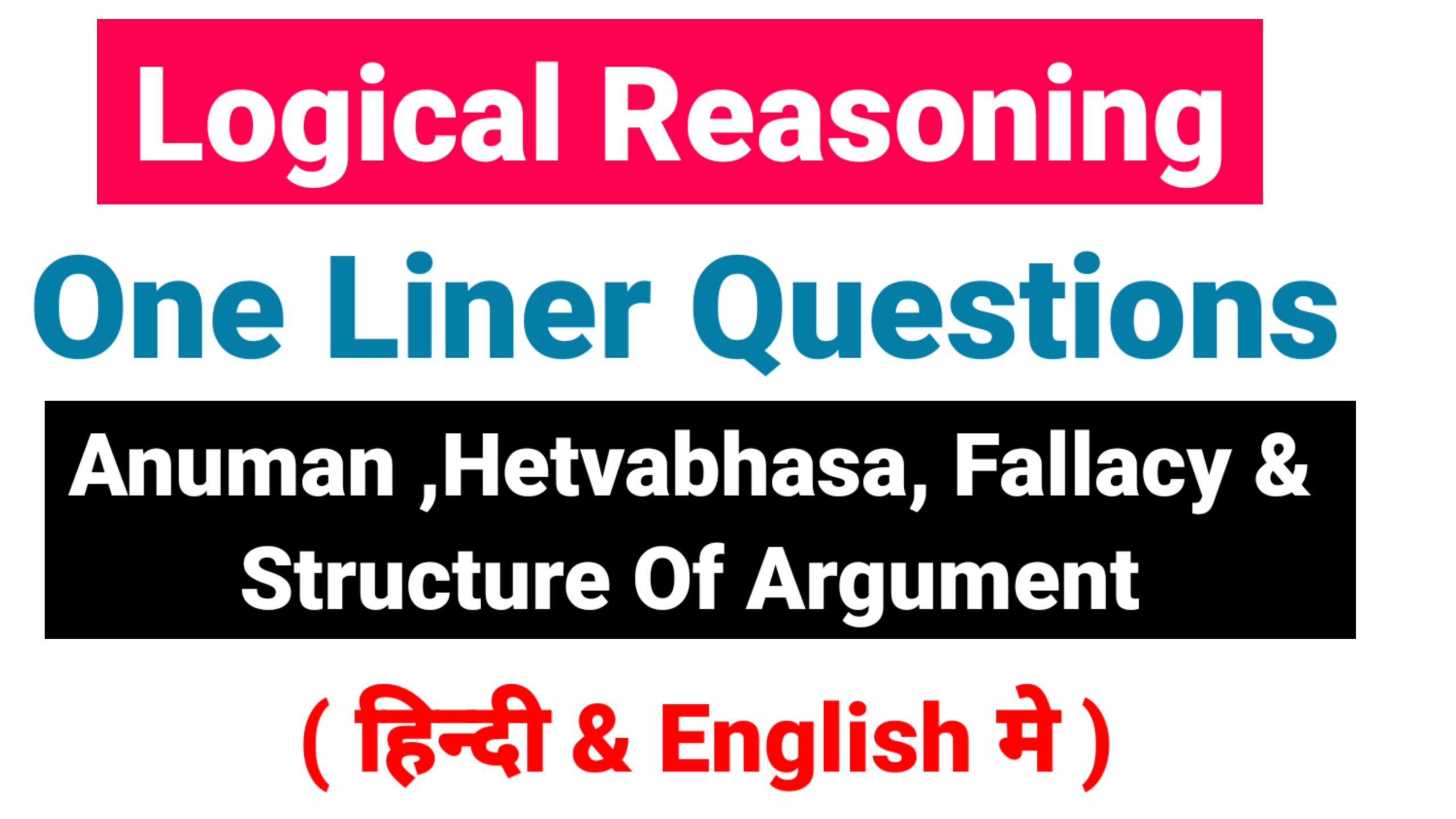
Let us see the various types of questions that may come in the Logical Reasoning One Liner Questions For UGC NET /SET/UPSC one by one from below.
Structure and Kinds of Anumana, Vyapti, Hetvabhasas One Liner Questions :Logical Reasoning One Liner Questions For UGC NET /SET/UPSC
What are the 5 types of hetvabhasa?
They are five kinds of hetvabhasa viz. savyabhicara (anaikantika), asiddha, viruddha, satpratipaksita and badhita.
हेत्वभास के 5 प्रकार क्या हैं?
वे पाँच प्रकार के हेत्वभास हैं। सव्यभिचार (अनिकांतिका), असिद्ध, विरुद्ध, सतप्रतिपक्षिता और बढ़िता ।
What are the structures and kinds of Anuman?
Structures of Anumāna: In every anumāna, there are 03 terms viz. Sadhya, Paksa and Hetu. These 03 terms correspond to the major, minor and middle terms respectively. Hetu is also called linga.
अनुमन की संरचना और प्रकार क्या हैं?
अनुमान की संरचनाएं: प्रत्येक अनुमान में 03 शब्द होते हैं जैसे। साध्या, पक्षा और हेतु । ये 03 पद क्रमशः प्रमुख, लघु और मध्य पदों के अनुरूप हैं। हेटू को लिंग भी कहा जाता है
What are the two kinds of vyapti?
Vyapti guarantees the truth of conclusion. It signifies the relation of invariable concomitance between “hetu” and “sadhya” and is of two kinds. Vyapti between terms of unequal extension is called “asamavyavyapti” or “visamavyapti”, and vyapti between equal extensions is called “samavyapti”.
व्यप्ति के दो प्रकार कौन से हैं?
व्यप्ति निष्कर्ष की सच्चाई की गारंटी देता है। यह “हेतु” और “साध्य” के बीच अपरिवर्तनीय सहवर्ती संबंध को दर्शाता है और दो प्रकार का होता है। असमान विस्तार के पदों के बीच व्यप्ति को “असमव्याप्ति” या “विषमव्यप्ति” कहा जाता है, और समान विस्तारों के बीच व्यप्ति को “समव्याप्ति” कहा जाता है ।
What is the role of vyapti in anumana?
Vyapti: Anumana is a process of arriving at truth not by direct observation but by means of the knowledge of Vyapti. When a universal relation between fire and smoke is known, it is called Vyapti. Vyapti is an important factor for attaining inferential knowledge.
अनुमान में व्यप्ति की क्या भूमिका है?
व्याप्ति: अनुमान प्रत्यक्ष अवलोकन द्वारा नहीं बल्कि व्याप्ति के ज्ञान के माध्यम से सत्य तक पहुँचने की एक प्रक्रिया है। जब अग्नि और धुएँ के बीच एक सार्वभौमिक संबंध ज्ञात हो जाता है, तो उसे व्याप्ति कहा जाता है। व्याप्ति अनुमानात्मक ज्ञान प्राप्त करने के लिए एक महत्वपूर्ण कारक है
What is Hetvabhasa in Anumana?
Hetvābhāsa is defined as something which seems to be a true hetu but which is wrong and which prevents us from arriving at an anumāna.
अनुमान में हेत्वभास क्या है?
हेत्वाभास को एक ऐसी चीज़ के रूप में परिभाषित किया गया है जो एक वास्तविक हेतु प्रतीत होती है लेकिन जो गलत है और जो हमें एक अनुमान तक पहुँचने से रोकती है ।
What is the concept of Hetvabhasa?
Hetvabhasa:Hetvabhasa is a Sanskrit term which means fallacy in the english language.In other words, in Indian logic, a fallacy is called hetvabhasa. A fallacy occurs when the middle term appears to be the reason but it is not a valid reason. There are five kinds of fallacies according to Nyaya school.
हेत्वभास की अवधारणा क्या है?
हेतवभास: हेत्वभास एक संस्कृत शब्द है जिसका अर्थ अंग्रेजी भाषा में भ्रम है । दूसरे शब्दों में, भारतीय तर्क में, एक भ्रम को हेत्वभास कहा जाता है। भ्रम तब होता है जब मध्य पद कारण प्रतीत होता है लेकिन यह वैध कारण नहीं होता है। न्याय स्कूल के अनुसार पाँच प्रकार की भ्रांतियाँ हैं।
What is a hetvabhasa in logic?
Hetvabhasa is an important Sanskrit term that means fallacy in the English language A fallacy is the use of invalid or otherwise faulty reasoning or ‘wrong moves in the construction of an argument.
तर्क में हेत्वभास क्या है?
हेत्वभास एक महत्वपूर्ण संस्कृत शब्द है जिसका अर्थ है अंग्रेजी भाषा में भ्रम एक तर्क के निर्माण में अमान्य या अन्यथा दोषपूर्ण तर्क या ‘गलत कदम’ का उपयोग है । यह यूजीसी नेट पाठ्यक्रम का एक महत्वपूर्ण हिस्सा है और आम तौर पर भारतीय तर्क विषय में आता है
How many kinds of arguments are there in logic?
The three types of argument in logic are deductive, inductive, and abductive. Regardless of the kind of logic being used, each argument will have the same components of a logical argument, namely premises and a conclusion.
तर्कशास्त्र में कितने प्रकार के तर्क होते हैं?
तर्कशास्त्र में तीन प्रकार के तर्क निगमनात्मक, आगमनात्मक और अपवर्तक होते हैं । चाहे जिस प्रकार के तर्क का उपयोग किया जा रहा हो, प्रत्येक तर्क में तार्किक तर्क के समान घटक होंगे, अर्थात् परिसर और निष्कर्ष।
What is Anumana in philosophy?
anumana, (Sanskrit: “measuring along some other thing” or “inference”) in Indian philosophy, the second of the pramanas, or the five means of knowledge.
दर्शनशास्त्र में अनुमान क्या है?
अनुमान, (संस्कृत: “किसी अन्य चीज़ के साथ मापना” या “अनुमान”) भारतीय दर्शन में, दूसरा प्रमाण, या ज्ञान के पाँच साधन ।
What are the types of Savyabhicara?
Savyabhicara fallacy is of three kinds i.e., sadharana, asadharana and anupasamhari.
सव्यभिचार कितने प्रकार के होते हैं?
सव्यभिचार भ्रांति तीन प्रकार की होती है, अर्थात् साधना, असधारण और अनुपसंहारी ।
What are the 4 types of logic?
The four main types of logic are:
- Informal logic: Uses deductive and inductive reasoning to make arguments.
- Formal logic: Uses syllogisms to make inferences.
- Symbolic logic: Uses symbols to accurately map out valid and invalid arguments.
- Mathematical logic Uses mathematical symbols to prove theoretical arguments.
तर्क के 4 प्रकार क्या हैं?
तर्क के चार मुख्य प्रकार हैं:
- अनौपचारिक तर्क: तर्क देने के लिए निगमनात्मक और आगमनात्मक तर्क का उपयोग करता है।
- औपचारिक तर्क: अनुमान लगाने के लिए न्यायवाक्य का उपयोग करता है।
- प्रतीकात्मक तर्क: वैध और अमान्य तर्कों को सटीक रूप से मैप करने के लिए प्रतीकों का उपयोग करता है।
- गणितीय तर्क सैद्धांतिक तर्कों को सिद्ध करने के लिए गणितीय प्रतीकों का उपयोग करता है।
What are the 4 types of arguments?
Let’s find out.
- Type 1: Deductive Arguments.
- Type 2: Inductive Arguments.
- Type 3: Toulmin Argument.
- Type 4: Rogerian Argument.
4 प्रकार के तर्क क्या हैं?
चलो पता करते हैं।
- टाइप 1: डिडक्टिव तर्क।
- प्रकार 2: आगमनात्मक तर्क।
- टाइप 3: टॉलमिन तर्क।
- टाइप 4: रोजरियन तर्क।
Vyāpti is established only by the uncontradicted experience of the relation, which exists between two things. Vyāpti literally means pervasion. Vyāpti implies a correla- tion between two facts, of which one is pervaded (vyāpti) and the other pervades (vāpaka).
व्यप्ति की स्थापना कैसे होती है?
व्याप्ति संबंध के अप्रतिबंधित अनुभव से ही स्थापित होती है , जो दो चीजों के बीच मौजूद है। व्याप्ति का शाब्दिक अर्थ है व्याप्ति। व्याप्ति का तात्पर्य दो तथ्यों के बीच संबंध से है, जिनमें से एक व्याप्त है (व्याप्ति) और दूसरा व्याप्त है (वापक)।
अनुमन के 5 चरण क्या हैं?
अनुमान में पाँच चरण होते हैं: एक परिकल्पना (प्रतिज्ञा), कारण (हेतु), एक उदाहरण (उदाहरन), पुन: पुष्टि (उपनयन), और निष्कर्ष (निगमन)
What are the 5 steps of Anuman?
Anumana consists of five steps: a hypothesis (pratijna), reason (hetu), an example (udaharana), reaffirmation (upanayana), and conclusion (nigamana).
What is Satpratipaksha?
—m. (-kṣaḥ) Contrariety of doctrine or argument, knowledge of the opposite arguments proving the existence or non-existence of a thing; viz:—sound is eternal because it is audible; on the other hand sound is non-eternal because it is a product, (in logic.) E. sat being, pratipakṣa opposition
सतप्रतिपक्ष क्या है?
-एम। (-क्षः) सिद्धांत या तर्क के विपरीत, किसी चीज़ के अस्तित्व या गैर-अस्तित्व को साबित करने वाले विपरीत तर्कों का ज्ञान; अर्थात:—ध्वनि शाश्वत है क्योंकि यह श्रव्य है; दूसरी ओर ध्वनि गैर-शाश्वत है क्योंकि यह एक उत्पाद है, (तर्क में।) ई। सत्, प्रतिपक्ष विरोध
What is an example of a Savyabhicara?
Savyabhicara or the fallacy of irregular middle: a middle term may be irregularly related to the major term. When the middle is not uniformly related to the major term then that is called savyabhicara hetu. example: all bipeds are rational. swans are bipeds.
सव्यभिचार का उदाहरण क्या है?
सव्यभिचार या अनियमित मध्य का भ्रम: एक मध्य पद अनियमित रूप से प्रमुख शब्द से संबंधित हो सकता है। जब मध्य का संबंध प्रमुख पद से समान रूप से नहीं होता है तो उसे सव्यभिचार हेतु कहा जाता है। उदाहरण: सभी द्विपाद तर्कसंगत हैं। हंस द्विपाद हैं।
How many types of sannikarsha are there?
DIFFERENT TYPES OF OPERATIVE RELATION (Sannikarsa)
According to Naiyayikas there are six types of operative relation in the case of ordinary perception (Laukika pratyaksa). (i) When we perceive a substance like a pot or cloth, we perceive it by the visual or tactile sense organs.
सन्निकर्ष कितने प्रकार के होते हैं?
क्रियात्मक संबंध के विभिन्न प्रकार (सन्निकार)
नैय्यिका के अनुसार सामान्य धारणा (लौकिका प्रत्यक्ष) के मामले में छह प्रकार के क्रियात्मक संबंध होते हैं। (i) जब हम बर्तन या कपड़े जैसे किसी पदार्थ का अनुभव करते हैं, तो हम इसे दृश्य या स्पर्श ज्ञानेंद्रियों द्वारा अनुभव करते हैं।
Who is the father of logic?
Aristotle: The Father of Logic (The Greatest Greek Philosophers)
तर्क का जनक कौन है?
अरस्तू : तर्क के पिता (महानतम यूनानी दार्शनिक
What is the difference between prama and aprama?
Knowledge in Sanskrit is called prama, it means true cognitions which contribute to knowledge. On the other hand, false cognitions which contribute to false knowledge are called aprama.
प्रमा और अपरामा में क्या अंतर है?
संस्कृत में ज्ञान को प्रमा कहा जाता है, इसका अर्थ है सच्ची अनुभूति जो ज्ञान में योगदान करती है। दूसरी ओर, मिथ्या संज्ञान जो मिथ्या ज्ञान में योगदान करते हैं, अपरामा कहलाते हैं ।
What is Paksadharmata?
The presence of the middle term in the minor term is called Paksadharmata and the invariable association of the middle term with the major term is called Vyāpti. The knowledge of Paksadharmata as qualified by Vyāpti is called Parāmarsa.
पक्षधरमाता क्या है?
मध्य पद का गौण पद में होना पक्षधर्मता कहलाता है और मध्य पद का प्रमुख पद से अविच्छिन्न साहचर्य व्याप्ति कहलाता है। व्यासपति द्वारा योग्य रूप में पक्षधरमाता के ज्ञान को परामर्स कहा जाता है।
What is the repudiation of Sadhya by Hetu?
The fallacy (hetvabhasha) produced in the conclusion due to the repudiation (to refuse to accept ) of Sadhya by Hetu is known as Viruddha. Fallacy (hetvabhasha): It is a middle term or appears to a reason but not a valid reason.
हेतु द्वारा साध्या का खंडन क्या है?
हेतु द्वारा साध्या के खंडन ( स्वीकार करने से इंकार करने ) के कारण निष्कर्ष में उत्पन्न होने वाली भ्रांति ( हेत्वभाषा) विरुद्ध के नाम से जानी जाती है। भ्रम (हेत्वभाषा): यह एक मध्य पद है या एक कारण प्रतीत होता है लेकिन एक वैध कारण नहीं है।
- PhD Admission through Net Entrance Exam : UGC New ChangesPhD Admission through Net Entrance Exam as per UGC New Policy – The University Grants Commission (UGC) has asked the higher education institutions (HEIs)
- CDP MCQ Question Quiz (Child Development & Pedagogy )
- ICT Important MCQ Quiz (Information & Communication Technology )ICT Important MCQ
- UGC NTA Revised New Syllabus 2024 Paper 1 & Paper 2 Check hereUGC NTA Revised New Syllabus 2024 has been released on the official website. Aspirants can download UGC NET Syllabus 2024 PDF
- UGC NET Question Paper Dec 2023 PDF DownloadUGC NET Question Paper Dec 2023 that has been provided to you here. Download UGC NET 2024/2023/2022/2021 and more question paper with answer key.

















